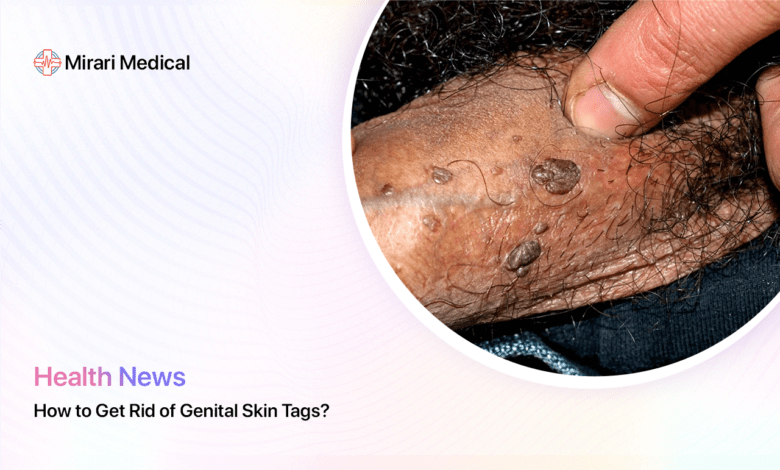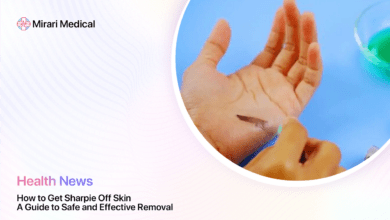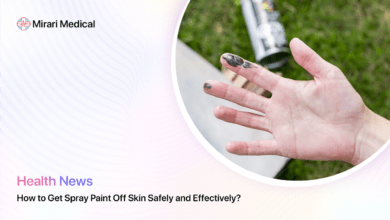How to Get Rid of Genital Skin Tags?

You may be interested
Did you know that nearly half of all adults will develop at least one skin tag in their lifetime? While these small, soft growths are usually harmless, getting skin tags in the genital area can be especially bothersome and embarrassing. If you’re dealing with genital skin tags, you’re probably wondering how to safely get rid of them.
In this comprehensive guide, we’ll cover everything you need to know about removing genital skin tags, from what causes them to the most effective treatment options. With our expert tips and advice, you’ll be able to say goodbye to pesky skin tags and hello to clearer, more comfortable skin down there. Let’s dive in!
Understanding Genital Skin Tags
Before we get into how to remove genital skin tags, it’s important to understand what they are and why they form. Skin tags, medically known as acrochordons, are small, soft, skin-colored growths that hang off the skin by a thin stalk or peduncle. They are made up of loose collagen fibers and blood vessels surrounded by skin.
Skin tags are benign, meaning they are not cancerous. They can range in size from a few millimeters to several centimeters wide. While skin tags can develop anywhere on the body, they are particularly common in areas where skin rubs together, such as the neck, armpits, under the breasts, and in the genital area.
Why Do Genital Skin Tags Form?
The exact cause of skin tags is unknown, but there are several factors that may contribute to their development, especially in the genital region:
- Friction: Repeated rubbing of skin against skin or clothing can irritate the skin and lead to skin tag formation. In the genital area, this can occur from tight clothing, sexual activity, or exercise.
- Hormonal changes: Fluctuations in hormone levels, such as during pregnancy, may increase the likelihood of developing skin tags.
- Genetics: Some people may be more prone to getting skin tags due to their genes. If your parents or siblings have skin tags, you may be more likely to get them too.
- Obesity and diabetes: Being overweight or having diabetes can increase your risk of developing skin tags, including in the genital area.
It’s important to note that genital skin tags are not contagious and are not caused by lack of hygiene or sexually transmitted infections. They are simply a common skin condition that can affect anyone.
Symptoms of Genital Skin Tags
Genital skin tags are usually painless and don’t cause any symptoms unless they become irritated. Some signs and symptoms to watch for include:
- Small, soft, flesh-colored growths around the genitals, inner thighs, or anus
- Growths that are connected to the skin by a thin stalk
- Skin tags that become red, inflamed, or painful if twisted or irritated by clothing
- Itching or discomfort in the affected area
If you notice any unusual growths or changes in your genital area, it’s important to have them checked out by a doctor to rule out other conditions and get an accurate diagnosis.
Professional Removal Methods for Genital Skin Tags
While it may be tempting to try to remove genital skin tags at home, it’s not recommended. The genital area is delicate and prone to infection, so it’s best to leave skin tag removal to the professionals. Here are some of the most common methods dermatologists and other skin specialists use to safely get rid of genital skin tags:
Cryotherapy
Cryotherapy, or freezing, is a quick and effective way to remove skin tags. The doctor will apply liquid nitrogen to the skin tag using a spray device or cotton swab. The extreme cold destroys the skin cells, causing the tag to fall off within a few days.
Cryotherapy is usually well-tolerated, but you may experience some mild discomfort or stinging during the procedure. The treated area may be red and tender for a few days afterward, but should heal quickly with proper care.
Electrosurgery
Electrosurgery involves using a small probe to deliver an electric current to the base of the skin tag. The heat from the current cauterizes the blood vessels and destroys the tissue, causing the tag to fall off.
This method is quick and precise, allowing the doctor to remove even very small skin tags. You may feel a slight burning sensation during the procedure, but it is usually not painful. The treated area may be red and tender for a few days, but should heal within a week or two.
Surgical Excision
For larger skin tags or those in hard-to-reach areas, your doctor may recommend surgical excision. This involves numbing the area with a local anesthetic and using a scalpel or surgical scissors to carefully cut off the skin tag at its base.
Surgical excision may require stitches to close the wound, depending on the size and location of the skin tag. You may experience some mild pain and swelling after the procedure, but this can be managed with over-the-counter pain relievers and ice packs.
Ligation
Ligation involves tying off the base of the skin tag with surgical thread to cut off its blood supply. Over time, the skin tag will shrivel up and fall off on its own.
This method is less commonly used for genital skin tags, as it can be more uncomfortable and take longer to work than other methods. However, it may be an option for people who cannot tolerate other removal methods due to allergies or other medical conditions.
Regardless of which method your doctor recommends, genital skin tag removal is usually a quick and straightforward in-office procedure. Most people can return to their normal activities immediately afterward, although you may need to avoid sexual activity or tight clothing for a few days to allow the area to heal.
What to Avoid When Treating Genital Skin Tags
While it’s important to remove genital skin tags safely and effectively, there are also some things you should avoid doing to prevent complications or further irritation. Here are some key things to keep in mind:
Don’t Try to Remove Them Yourself
As tempting as it may be to try to cut, pull, or tie off genital skin tags yourself, it’s not worth the risk. Attempting to remove skin tags at home can lead to:
- Pain and discomfort
- Excessive bleeding
- Infection from unsterile tools or techniques
- Scarring or skin damage
- Incomplete removal, leading to regrowth
Even if you manage to remove the skin tag successfully, you may still be left with a painful, open wound that is prone to infection. It’s always best to leave skin tag removal to a trained medical professional who can do it safely and effectively.
Be Cautious with Over-the-Counter Removal Products
There are many over-the-counter (OTC) products marketed for skin tag removal, such as freezing kits, creams, and patches. However, these products are not always safe or effective, especially for use in the genital area.
The skin around the genitals is much more delicate and sensitive than other areas of the body, so using harsh chemicals or abrasive methods can easily cause irritation, burning, or even chemical burns. Some OTC products may also contain ingredients that can interact with other medications or cause allergic reactions.
If you’re considering using an OTC product to remove genital skin tags, talk to your doctor first. They can advise you on whether the product is safe and appropriate for your specific situation, or recommend a more suitable treatment option.
Don’t Ignore Changes or Symptoms
While genital skin tags are usually harmless, it’s important to keep an eye out for any changes or symptoms that could indicate a more serious problem. See your doctor right away if you notice:
- Rapid growth or change in size of a skin tag
- Bleeding or discharge from a skin tag
- Skin tags that are painful, itchy, or tender to the touch
- Skin tags that change color or texture
- Sores or ulcers that develop on or around a skin tag
These could be signs of an infection, skin cancer, or another underlying health condition that requires prompt medical attention. Don’t ignore symptoms or try to self-diagnose – always err on the side of caution and get checked out by a professional.
When to See a Doctor About Genital Skin Tags
Even if your genital skin tags aren’t causing any symptoms, it’s still a good idea to have them evaluated by a doctor. Here are some situations when you should make an appointment:
If You’re Not Sure It’s a Skin Tag
Genital skin tags can sometimes be confused with other skin growths, such as genital warts, moles, or even skin cancer. If you’re not 100% sure that what you have is a skin tag, get it checked out by a dermatologist or other qualified healthcare provider.
They can examine the growth and determine whether it’s a harmless skin tag or something more serious that requires further testing or treatment. It’s always better to be safe than sorry when it comes to your health.
If You Have Multiple Skin Tags
Having one or two skin tags is usually nothing to worry about, but if you develop multiple skin tags in a short period of time, it could be a sign of an underlying health condition. For example, people with diabetes or insulin resistance are more prone to developing skin tags, including in the genital area.
If you notice a sudden crop of skin tags, make an appointment with your doctor to rule out any potential health issues. They may recommend blood tests or other diagnostic procedures to check for diabetes, hormonal imbalances, or other conditions that could be contributing to your skin tags.
If the Skin Tag is Bothersome
Even if a genital skin tag is benign, it can still be annoying or embarrassing. Skin tags can catch on clothing, become irritated, or interfere with sexual activity. If a skin tag is bothering you or affecting your quality of life, don’t hesitate to talk to your doctor about removal options.
Most insurance plans consider skin tag removal to be a cosmetic procedure, so it may not be covered. However, if the skin tag is causing physical discomfort or other symptoms, your doctor may be able to bill it as a medically necessary procedure. It never hurts to ask!
If You’re Prone to Skin Tags
Some people are simply more prone to developing skin tags than others, whether due to genetics, hormonal factors, or other underlying health conditions. If you’ve had genital skin tags before and tend to get them frequently, it’s a good idea to have regular check-ups with a dermatologist or other skin specialist.
They can help you keep an eye out for any new or changing skin growths, as well as recommend strategies for preventing skin tags from developing in the first place. This may include maintaining a healthy weight, wearing loose-fitting clothing, and avoiding excessive friction or irritation in the genital area.
The Bottom Line on Genital Skin Tags
Genital skin tags are a common and usually harmless skin condition that can affect anyone. While they may be unsightly or uncomfortable, they are not a sign of poor hygiene or a sexually transmitted infection. With the right treatment and care, most genital skin tags can be safely and effectively removed by a qualified medical professional.
If you’re dealing with skin tags in your genital area, don’t panic – and definitely don’t try to remove them yourself at home. Schedule an appointment with a dermatologist or other skin specialist to have the growths evaluated and discuss your treatment options. With their help, you can say goodbye to pesky skin tags and hello to clearer, more comfortable skin in your most intimate areas.
Remember, when it comes to your health, it’s always better to be proactive and informed. By taking charge of your skin health and seeking professional guidance when needed, you can keep your skin looking and feeling its best – from head to toe!
Your trusted source for health info, offering expert advice, news, and tips to stay healthy and informed.





